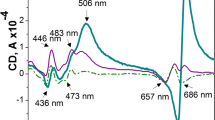Abstract
Negative staining electron microscopy showed that purple membranes isolated from Halobacterium halobium are aggregated in vitro in the form of stacked arrays. This effect is more marked after trypsin treatment. White membranes isolated from mutant strains do not stack and exhibit an average size consistent with previous results of electron microscopy. White membrane fragments also do not exhibit stacking in vitro after retinal reconstitution or trypsin treatment. Quasi-elastic light scattering was also used to characterize the size (hydrodynamic radius) of isolated purple and white membranes before and after proteolysis. These results also show that native purple membrane preparations are larger in size than expected and that, following trypsin treatment, they are on average more than an order of magnitude larger. In stacked purple preparations, cations are unable to exchange freely with the aqueous medium. This explains why proteolysis lowers the efficiency of proton release by illuminated bacteriorhodopsin in purple membranes in vitro. Thus, previously reported decreases in efficiency of proton release by bacteriorhodopsin in proteolyzed purple membranes are due to the stacking effect and not per se to loss of the carboxyl terminus tail.
Access this chapter
Tax calculation will be finalised at checkout
Purchases are for personal use only
Preview
Unable to display preview. Download preview PDF.
Similar content being viewed by others
References
Blaurock, A.E., Stoeckenius, W., Oesterhelt, D., and Scherphof, G.L. Sturcture of the cell envelope of Halobacterium halobium (1970) J. Cell. Biol. 71, 1–22.
Fisher, K., Yanagimoto, K., and Stoeckenius, W. Oriented absorption of purple membrane to cationic surfaces (1978) J. Cell Biol. 77, 611–621.
Fahr, A. and Bamburg, E. Photocurrents of dark-adapted bacteriorhodopsin on black lipid membranes (1982) FEBS Lett. 140, 251–253.
Kuschmitz, D. and Hess, B. On the ratio of the proton and photochemical cycles in bacteriorhodopsin (1981) Biochemistry 20, 5950–5957.
Lozier, R.H., Niederberger, W., Bogomolni, R.N., Hwang, S., and Stoeckenius, W. Kinetics and stoichiometry of light-induced proton release and uptake from purple membrane fragments, Halobacterium halobium cell envelopes, and phospholipid vesicles containing oriented purple membrane (1976) Biochim. Biophys. Acta, 440, 545–556.
Govindjee, R., Ebrey, T.G., and Crofts, A.R. The quantum efficiency of proton pumping by the purple membrane of Halobacterium halobium (1980) Biophys, J. 30, 231–242.
Govindjee, R., Ohno, K., and Ebrey, T.G. Effect of removal of the C-terminal region of bacteriorhodopsin on its light-induced H+ changes (1982) Biophys J. 38, 85–87.
Gerber, G.E., Wildenauer, D., Khorana, H.G. Orientation of bacteriorhodopsin generate a membrane potential (1977) Proc. Natl. Acad. Sci. USA 74, 5426–5430.
Ovchinnikov, Y.A., Abdulaev, N.G., Feigina, M.Y., Kiselev, A.V., and Lobanov, N.A. Recent findings in the structure-functional characteristics of bacteriorhodopsin (1977) FEBS Lett. 84, 104.
Liao, M.-J. and Khorana, H.G. Removal of the carboxyl-terminal peptide does not affect refolding or function of bacteriorhodopsin as a light dependent proton pump (1984) J. Biol. Chem. 259, 4194–4199.
Govindjee, R., Ohno, K., Chang, C.-H., and Ebrey, T.G. In: Transduction in Biological Membranes, New York: Plenum Press. In press.
Oesterhelt, D. and Stoeckenius, W. Isolation of the cell membrane of Halobacterium halobium and its fractionation into red and purple membrane (1974). In: Methods in Enzymology (S. Fleischer and L. Packer, eds.), Vol. 31, Academic Press, pp. 667–678.
Oesterhelt, D. Reconstitution of the retinal proteins bacteriorhodopsin and halorhodopsin (1982). In: Methods of Enzymology (L. Packer, ed.), Vol. 88, Academic Press, pp. 10–17.
Mukohata, Y., Sugiyama, Y., Kaji, Y., Usukura, J., and Yamada, E. The white membrane of crystalline bacteriorhodopsin in Halobacterium halobium strain R1mW and its conversion into purple membrane by exogenous retinal (1981) Photochem. Photobiol. 33, 593–600.
Katsura, T., Lam, E., Packer, L., and Seltzer, S. Light dependent modification of bacteriorhodopsin by tetranitromethane. Interaction of a tyrosine and a tryptophan residue with bound retinal (1982) Biochem. Internatl. 5, 445–456.
Scherrer, P., Packer, L., and Seltzer, S. Effect of iodination of purple membrane on the photocycle of bacteriorhodopsin (1981) Arch. Biochem. Biophys. 202, 589–601.
Ware, B.R. and Haas, D.D. Electrophoretic light scattering (1983) In: Fast Methods in Physical Biochemistry and Cell Biology (R.I. Sha’afi and S.M. Fernandez, eds. ), Elsevier Science Publishers, pp. 174–220.
Arrio, B., Johannin, G., Carrette, A., Chevallier, J., and Brethes, D. Electrokinetic and hydrodynamic properties of sarcoplasmic reticulum vesicles: a study by laser Doppler electrophoresis and quasi-elastic light scattering (1984) Arch. Biochem. Biophys. 288, 220–229.
Arrio, B., Johannin, G., Volfin, P., and Packer, L. Quasi-elastic laser light scattering and Doppler electrophoresis of purple membranes (1984) Biophys, Soc. Abstr. 45, 212a.
Haschemeyer, R.M. and Myers, R.J. (1972) In: Principles and Techniques of Electron Microscopy (M.A. Hayat, ed.), Vol. 2, Van Nostrand Reinhold Company, pp. 99–147.
Packer, L., Tristram, S., Herz, J., Russell, C., and Borders, C.L. Chemical modification of purple membranes: role of arginine and carboxylic acid residues in bacteriorhodopsin (1971) FEBS Lett. 108, 243248.
Wallace, B.A. and Henderson, R. Location of the carboxyl terminus of bacteriorhodopsin in purple membrane (1982) Biophys. J. 39, 233–239.
Walsh, K.A. Trypsinogens and trypsin of various species (1971) In: Methods in Enzymology (G.E. Perlmann and L. Lorand, eds.), Vol. 19, pp. 41–63.
Abdulaev, N., Feigina, M., Kiselov, A., Ovchinnikov, Y., Drachev, L., Kauger, A., Knitrina, L., and Skulachev, V. Products of limited proteolysis of bacteriorhodopsin generate a membrane potential (1978) FEBS Lett. 90, 190–194.
Ovchinnikov, Y.A. (1984) In: EMBO Workshop on Molecular Biology of Retinal Proteins.
Author information
Authors and Affiliations
Editor information
Editors and Affiliations
Rights and permissions
Copyright information
© 1986 Plenum Press, New York
About this chapter
Cite this chapter
Lefort-Tran, M., Pouphile, M., Arrio, B., Johannin, G., Volfin, P., Packer, L. (1986). Stacking of Purple Membranes in Vitro . In: Papageorgiou, G.C., Barber, J., Papa, S. (eds) Ion Interactions in Energy Transfer Biomembranes. Springer, Boston, MA. https://doi.org/10.1007/978-1-4684-8410-6_19
Download citation
DOI: https://doi.org/10.1007/978-1-4684-8410-6_19
Publisher Name: Springer, Boston, MA
Print ISBN: 978-1-4684-8412-0
Online ISBN: 978-1-4684-8410-6
eBook Packages: Springer Book Archive




